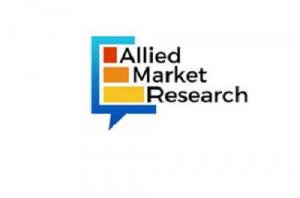Pressure Vessel Market to Hit $33.7 Bn by 2030 | Growth Driven by Energy Demand
Stricter safety rules and new energy projects are reshaping the market — compliance and innovation now determine which suppliers win long-term contracts.
WILMINGTON, DE, UNITED STATES, September 19, 2025 /EINPresswire.com/ -- According to a new report published by Allied Market Research, titled, “Pressure Vessel Market for Alternative Fuels, by Material (Hastelloy, Titanium, Nickel & Nickel Alloys, Tantalum, Steel, and Others), Product (Boiler, Nuclear Reactor, Separator, and Others), and End Use (Chemicals & Petrochemicals, Oil & Gas, Power Generation, and Fertilizers): Global Opportunity Analysis and Industry Forecast 2021-2030" The global pressure vessel market size for alternative fuels was valued at $21.9 billion in 2020, and is projected to reach $33.7 billion by 2030, growing at a CAGR of 4.4% from 2020 to 2030.The global pressure vessel market comprises manufacturers and service providers that design, fabricate, install, inspect, and maintain vessels used to contain gases or liquids at pressures different from ambient. Demand is driven by oil & gas, petrochemicals, power generation, chemicals, and industrial manufacturing, where vessels are critical for storage, reaction, separation and heat exchange. Regulatory safety standards, materials technology, and aftermarket inspection services strongly influence purchasing decisions and lifecycle costs.
𝗗𝗼𝘄𝗻𝗹𝗼𝗮𝗱 𝗣𝗗𝗙 𝗕𝗿𝗼𝗰𝗵𝘂𝗿𝗲: https://www.alliedmarketresearch.com/request-sample/A01891
𝗠𝗮𝗿𝗸𝗲𝘁 𝗗𝘆𝗻𝗮𝗺𝗶𝗰𝘀
• Demand drivers — energy & industrial activity. Expansion in upstream oil & gas, petrochemical capacity, and growing power-generation (including hydrogen and ammonia projects) are primary demand engines. Industrialization and a renewed focus on domestic manufacturing in several countries also increase need for bespoke and large-capacity vessels.
• Regulation & safety pressure. Stricter safety codes (ASME, PED and national standards), more frequent inspections, and liability considerations force operators to prioritize certified suppliers and invest in durable, inspectable designs. Compliance increases upfront cost but creates recurring revenue for certified inspection and refurbishment services.
• Materials, design and manufacturing evolution. Adoption of higher-strength alloys, corrosion-resistant linings, composite materials, and advanced welding/forming techniques allow lighter, more compact vessels and extend service life. Additive manufacturing and modular fabrication reduce lead times for complex, low-volume units.
• Aftermarket services & digitalization. Predictive maintenance, non-destructive testing (ultrasonic, radiography), and digital asset management (inspection drones, sensor monitoring) are becoming differentiators. Providers offering integrated lifecycle solutions (design → fabrication → inspection → repair) capture higher margins and longer customer relationships.
• Market challenges & opportunities. Volatile commodity prices and cyclic capital spending in oil & gas create short-term demand swings, while opportunities arise from energy transition projects (hydrogen, CO₂ capture, thermal storage) and from replacement of aging infrastructure worldwide.
𝗦𝗻𝗮𝗴 𝗗𝗶𝘀𝗰𝗼𝘂𝗻𝘁: https://www.alliedmarketresearch.com/checkout-final/A01891
𝗦𝗲𝗴𝗺𝗲𝗻𝘁 𝗢𝘃𝗲𝗿𝘃𝗶𝗲𝘄
The pressure vessel market analysis is segmented by product type (storage vessels, reactors, heat exchangers, autoclaves, boilers), material (carbon steel, stainless steel, nickel alloys, composites), pressure rating (low, medium, high), manufacturing method (shop-fabricated, site-erected), and end-use (oil & gas, power & utilities, chemicals, water treatment, food & beverage, pharmaceuticals, maritime, aerospace). Each segment has distinct certification, material and inspection needs that influence supplier selection and pricing.
𝗥𝗲𝗴𝗶𝗼𝗻𝗮𝗹 𝗔𝗻𝗮𝗹𝘆𝘀𝗶𝘀
Asia-Pacific leads in volume due to large-scale petrochemical, power and manufacturing projects, competitive fabrication capacity, and significant investments in infrastructure in China, India, South Korea and Southeast Asia. Rapid industrial expansion and competitive local manufacturers keep prices aggressive while improving local technical capabilities.
North America and Europe are mature, high-value markets that emphasize stringent certification, advanced materials and aftermarket services; growth is steadier but margins are higher. The Middle East remains a concentrated market for large, high-capacity vessels tied to oil & gas and refining projects, while Latin America and Africa represent emerging demand driven by resource development and infrastructure replacement.
𝗙𝗼𝗿 𝗣𝘂𝗿𝗰𝗵𝗮𝘀𝗲 𝗜𝗻𝗾𝘂𝗶𝗿𝘆:
https://www.alliedmarketresearch.com/purchase-enquiry/A01891
𝗖𝗼𝗺𝗽𝗲𝘁𝗶𝘁𝗶𝘃𝗲 𝗔𝗻𝗮𝗹𝘆𝘀𝗶𝘀
Competition is shaped by scale and certification: large global fabricators compete on engineering depth, certifications, and integrated project execution, while regional specialists win on speed, local compliance knowledge, and cost. Key competitive levers include turnaround time, custom engineering, material sourcing, and proven inspection/QA programs.
Consolidation, strategic partnerships and vertical integration (fabrication + inspection + digital monitoring) are common strategies to capture lifecycle value. New entrants often focus on niche opportunities—composite vessels, small-batch high-alloy fabrications, or digital inspection services—rather than full-scope EPC competition.
𝗞𝗲𝘆 𝗙𝗶𝗻𝗱𝗶𝗻𝗴𝘀 𝗼𝗳 𝘁𝗵𝗲 𝗦𝘁𝘂𝗱𝘆
• Energy transition projects (hydrogen, CO₂ capture, thermal storage) create new demand vectors beyond traditional oil & gas.
• Regulatory compliance and certification drive buyer preference toward established, accredited suppliers.
• Aftermarket inspection and digital monitoring are rapidly increasing in importance and revenue contribution.
• Materials and manufacturing innovations (high-strength alloys, composites, modular fabrication) reduce lifecycle costs but raise initial technical barriers.
• Market cyclicality from commodity-linked capex remains a key risk; diversification across end-uses and service offerings mitigates exposure.
𝗧𝗿𝗲𝗻𝗱𝗶𝗻𝗴 𝗥𝗲𝗽𝗼𝗿𝘁𝘀 𝗶𝗻 𝗜𝗻𝗱𝘂𝘀𝘁𝗿𝘆:
Bunker Fuel Market
https://www.alliedmarketresearch.com/bunker-fuel-market
Biomass Briquette Fuel Market
https://www.alliedmarketresearch.com/biomass-briquette-fuel-market-A279664
Gas-to-Liquid Fuels Market
https://www.alliedmarketresearch.com/gas-to-liquid-fuels-market-A306796
Second Generation Biofuels Market
https://www.alliedmarketresearch.com/second-generation-biofuels-market
Wood Pellet Fuel Market
https://www.alliedmarketresearch.com/wood-pellet-fuel-market
Water as a Fuel Market
https://www.alliedmarketresearch.com/water-as-a-fuel-market-A74596
Fuel Ethanol Market
https://www.alliedmarketresearch.com/fuel-ethanol-market-A16349
Emulsified Fuel Market
https://www.alliedmarketresearch.com/emulsified-fuel-market-A07249
Caribbean Islands Bunker Fuel Market
https://www.alliedmarketresearch.com/caribbean-islands-bunker-fuel-market
David Correa
Allied Market Research
+15038946022 ext.
email us here
Visit us on social media:
LinkedIn
Facebook
YouTube
X
Legal Disclaimer:
EIN Presswire provides this news content "as is" without warranty of any kind. We do not accept any responsibility or liability for the accuracy, content, images, videos, licenses, completeness, legality, or reliability of the information contained in this article. If you have any complaints or copyright issues related to this article, kindly contact the author above.

